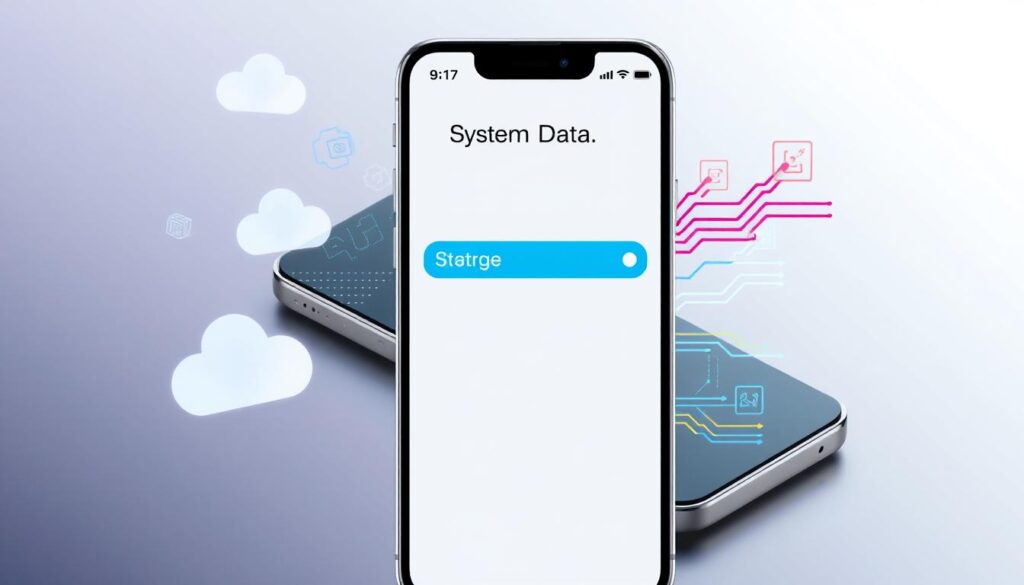iPhone users often face the challenge of limited storage. “System Data” is a big part of this problem. But what is System Data, and how does it affect your iPhone’s storage? We’ll explore System Data in detail, helping you understand its role in managing your iPhone’s storage.
Key Takeaways
- System Data refers to the essential files and information required for the proper functioning of your iPhone’s operating system.
- System Data accumulates over time as you use your iPhone, and it can gradually consume a larger portion of your device’s storage.
- Understanding the different types of System Data can help you better manage your iPhone’s storage and optimize its performance.
- Strategies like regularly clearing caches and offloading unused apps can help you reclaim storage space occupied by System Data.
- Monitoring System Data usage and addressing any unusual spikes or growth can prevent storage issues and ensure your iPhone runs smoothly.
Demystifying System Data on Your iPhone
Have you ever wondered about the “System Data” on your iPhone? It takes up a lot of space. You might be asking, “What is System Data, and why does it keep growing?” Let’s explore what this part of your iPhone’s storage is all about.
Understanding the Different Types of System Data
System Data includes many types of files and info. It’s all about keeping your iPhone running smoothly. This includes caches, logs, backups, and more. These are important for your device but can use up a lot of space.
Why System Data Accumulates Over Time
As you use your iPhone, it creates System Data. This includes things like:
- Cache files that help apps and services load faster
- Logs that track system events and troubleshoot issues
- Backups of your device’s settings and configurations
- Temporary files used by the operating system
As you keep using your iPhone, this data grows. This can make your storage space bigger. But, there are ways to free up system data on your iPhone and get back some space.
Knowing about System Data helps you manage it better. This way, your iPhone stays fast and has enough room for everything.
Identifying Major Contributors to System Data Usage
Understanding iPhone system data growth is key. Knowing what causes it helps you manage your device better. This way, you can stop system data from taking up too much space.
Apple’s software updates are a big reason for iPhone system data growth. These updates improve your device’s performance and security. But, they also add new files and system components, increasing data.
How you use your apps also matters. Apps that use your device’s camera or media playback a lot use more data. This data adds up over time and becomes part of iPhone system data.
Device settings and configurations also affect iPhone system data. Features like iCloud sync, system logs, and diagnostic data increase your device’s data footprint.
Knowing what contributes to iPhone system data helps you manage your device better. By being proactive, you can keep your iPhone system data in check. This ensures your device runs smoothly.
| Contributor | Impact on System Data |
|---|---|
| Software Updates | Increased system files and backup data |
| App Usage | Data generated and stored by apps |
| Device Settings | System logs and diagnostic data |
“Staying informed about the factors that contribute to iPhone system data growth is the first step towards taking control of your device’s storage and performance.”
what is system data on iphone
System data on your iPhone is a mystery to many. It’s a part of your device’s storage that can confuse and frustrate users. Knowing what system data is and how it affects your iPhone’s storage can help you manage it better.
How System Data Impacts Your iPhone’s Storage
System data includes files and info needed for your iPhone to work right. This includes cached files, system logs, and more. These are things iOS uses to keep your phone running smoothly.
But, system data can take up a lot of space on your iPhone. This is a problem when you try to update your iOS or install new apps. You need enough space for these things to work.
Strategies for Managing System Data Effectively
There are ways to handle system data on your iPhone and save space. Backing up and restoring your device can clear out system data. Deleting and reinstalling apps can also help reduce system data.
Restarting your iPhone regularly can also help. And, managing cache and temporary files can make a big difference. By using these methods, you can keep your iPhone running smoothly and have enough space for everything.

“Managing system data on your iPhone is key for keeping it running well and having enough storage.”
Troubleshooting Common Issues Related to System Data
Too much iphone system data can cause problems like less storage and slower devices. But, there are steps you can take to fix these issues. This will help your iPhone work better again.
Clearing System Data Effectively
Clearing iphone system data regularly is key. Here are some tips to help you do it:
- Use a good iphone system data cleanup tool to find and delete extra system files.
- Clear out cached data like browser histories and app caches, which can grow system data.
- Move apps you don’t use often to free up space and reduce system data.
iphone system data recommendations
There are also ways to stop system data from building up:
- Don’t let your device’s storage get too full, as it can lead to more system data.
- Back up your device often to clear space and cut down on system data.
- Keep your iOS software updated, as newer versions manage system data better.
By following these iphone system data cleanup and iphone system data recommendations, you can solve common system data problems. This will keep your iPhone running smoothly.

Conclusion
Understanding System Data on your iPhone is key to managing storage and improving performance. This article has broken down the different types of System Data and their major contributors. Now, you have the knowledge to manage your iPhone’s storage effectively.
By keeping an eye on your System Data, you can greatly enhance your iPhone experience. The strategies shared in this guide will help you free up valuable storage space. This ensures your device runs smoothly, without clutter.
If you have more questions or want to share your experiences with what is system data on iphone, we’re here to help. We’re always looking to hear from our readers and find ways to better assist you. This way, we can help you get the most out of your Apple device.
FAQ
What is System Data on an iPhone?
System Data on an iPhone is the space used by the operating system and system files. It includes caches, logs, and other data needed for your iPhone to work right.
How does System Data impact my iPhone’s storage?
System Data can take up a lot of space on your iPhone. This leaves less room for your apps, photos, and personal files. It’s key to manage System Data to keep your device running smoothly.
Why does System Data accumulate over time?
System Data grows over time because of app use, software updates, and settings. As you use your iPhone, it stores data to improve performance. This leads to more System Data usage.
How can I manage System Data on my iPhone?
You can manage System Data by clearing caches, deleting logs, and optimizing settings. Regular checks and maintenance help keep System Data in check.
What are the main contributors to System Data on my iPhone?
Main contributors to System Data are app caches, software updates, backups, and system processes. Knowing these can help you tackle excessive System Data.
How can I troubleshoot issues related to excessive System Data?
For storage or performance issues, try clearing app caches, deleting old backups, and setting up your device. Sometimes, you might need Apple support for help.







2 thoughts on “What is System Data on iPhone? Storage Explained”